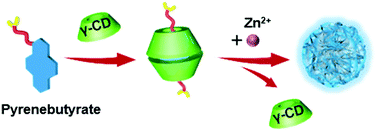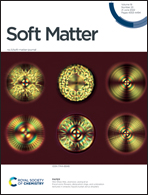Cyclodextrin-catalyzed self-assembly of a coordinating fluorescent molecule into microflowers†
Abstract
We report that γ-cyclodextrin (γ-CD) is able to catalyze the self-assembly process of the coordinating fluorescent molecule pyrenebutyrate with Zn2+. The direct interaction between pyrenebutyrate and Zn2+ would simply lead to amorphous precipitates, whereas addition of Zn2+ to the host–guest complex of pyrenebutyrate @ γ-CD would generate well-defined microflowers that have exactly the same composition as the amorphous pyrenebutyrate/Zn2+. The evidence of host–guest formation between 1-PBA and γ-CD and the absence of γ-CD in the final microflowers manifest that γ-CD acts as a catalyst in the self-assembly process. We envision that this dynamic host–guest chemistry would be very promising in creating catassemblies.



 Please wait while we load your content...
Please wait while we load your content...